- 請教張維為,知道無恥怎麼寫嗎? [2019/01]
- 論言論自由 [2020/01]
- 中國為什麼應該堅決拋棄佛教(1) [2020/06]
- 在文革中被迫害致死的美女們 [2018/11]
- 龍應台:聽了于丹的演講我真想自殺! [2019/07]
- 劉少奇誕生120周年群醜圖 [2018/11]
- 從《五·七一工程紀要》到習家軍 [2018/10]
- 毛澤東侄女文革遭火烤下體慘死內幕 [2018/11]
- 世界大瘟疫,中宣部很興奮 [2020/03]
- 大學:群獸亂交和群魔亂舞 [2018/04]
- 赤裸裸的謊言:「台灣,憑什麼讓我原諒你」 [2018/12]
- 惡夢。(記北京四中文革前的四清) [2018/09]
- 惡夢。續一。(記北京四中文革前的四清) [2018/09]
- 評「華二代坦言生存真相: 既不被美國圈子歡迎,也不被中國人接納」 [2018/12]
- 從中興變局看中國產業弊端 [2018/04]
- 武漢瘟疫與中國模式的破產 [2020/02]
- 文革餘毒習近平 (上) [2018/10]
- 掃購口罩的華人有錯嗎? [2020/04]
- 終結美國種族主義的最後一戰? [2020/09]
 Photo: Sarah Anne Ward
Photo: Sarah Anne WardBy the time you open a container of yogurt, the food has taken a long journey to reach your spoon. You may have some idea of that journey: From cow to processing to packaging to store shelves. But at each step, there is a chance for a little something extra to sneak in, a stowaway of sorts that shouldn』t be there.
That unexpected ingredient is something called a plasticizer: a chemical used to make plastic more flexible and durable. Today, plasticizers—the most common of which are called phthalates—show up inside almost all of us, right along with other chemicals found in plastic, including bisphenols such as BPA. These have been linked to a long list of health concerns, even at very low levels.
Consumer Reports has investigated bisphenols and phthalates in food and food packaging a few times over the past 25 years. In our new tests, we checked a wider variety of foods to see how much of the chemicals Americans actually consume. The answer? Quite a lot. Our tests of nearly 100 foods found that despite growing evidence of potential health threats, bisphenols and phthalates remain widespread in our food.
Bisphenols and phthalates in our food are concerning for several reasons.
To start, growing research shows that they are endocrine disruptors, which means that they can interfere with the production and regulation of estrogen and other hormones. Even minor disruptions in hormone levels can contribute to an increased risk of several health problems, including diabetes, obesity, cardiovascular disease, certain cancers, birth defects, premature birth, neurodevelopmental disorders, and infertility.
Those problems typically develop slowly, sometimes over decades, says Philip Landrigan, MD, a pediatrician and the director of the Program for Global Public Health and the Common Good at Boston College. "Unlike a plane crash, where everyone dies at once, the people who die from these die over many years."
Another concern is that with plastic so ubiquitous in food and elsewhere, the chemicals can』t be completely avoided. And though the human body is pretty good at eliminating bisphenols and phthalates from our systems, our constant exposure to them means that they enter our blood and tissue almost as quickly as they』re eliminated. And plasticizers in particular can easily leach out of plastic and other materials. In addition, the chemicals』 harmful effects may be cumulative, so steady exposure to even very small amounts over time could increase health risks.
All that makes it difficult to trace any particular bad health outcome—say, a heart attack or breast cancer—to the chemicals. And it makes it hard for regulators to set a limit for what is considered safe for any food. "As a first step, the key is to determine how widespread the chemicals are in our food supply," Rogers says. "Then we can develop strategies, as a society and individually, to limit our exposure."
To help figure out the scope of the problem, CR tested a wide range of food items, in a variety of packaging.
Specifically, we tested 85 foods, analyzing two or three samples of each. We looked for common bisphenols and phthalates, as well as some chemicals that are used to replace them. (Read more about these chemical substitutes.) We included prepared meals, fruits and vegetables, milk and other dairy products, baby food, fast food, meat, and seafood, all packaged in cans, pouches, foil, or other material.
The news on BPA and other bisphenols was somewhat reassuring: While we detected them in 79 percent of the tested samples, levels were notably lower than when we last tested for BPA, in 2009, "suggesting that we are at least moving in the right direction on bisphenols," says CR』s Rogers.
But there wasn』t any good news on phthalates: We found them in all but one food (Polar raspberry lime seltzer). And the levels were much higher than for bisphenols.
Determining an acceptable level for these chemicals in food is tricky. Regulators in the U.S. and Europe have set thresholds for only bisphenol A (BPA) and a few phthalates, and none of the foods CR tested had amounts exceeding those limits.
But "many of these thresholds do not reflect the most current scientific knowledge, and may not protect against all the potential health effects," says Tunde Akinleye, the CR scientist who oversaw CR』s tests. "We don』t feel comfortable saying these levels are okay," he says. "They』re not."
The decision to allow these chemicals in food "is not evidence-based," says Ami Zota, ScD, an associate professor of environmental health sciences at the Columbia University Mailman School of Public Health in New York City, who has studied the risks of phthalates.
For example, one of the most well-studied phthalates is called DEHP. Studies have linked it to insulin resistance, high blood pressure, reproductive issues, early menopause, and other concerns at levels well below the limits set by American and European regulators. It was the most common phthalate that we found in our tests, with more than half of the products we tested having levels above what research has linked to health problems.
In addition, Akinleye says that with exposure to these chemicals coming from so many sources—not only food but also other products, such as printed receipts and household dust— it』s difficult to quantify what a "safe" limit would be for a single food. "The more we learn about these chemicals, including how widespread they are, the more it seems clear that they can harm us even at very low levels," he says.
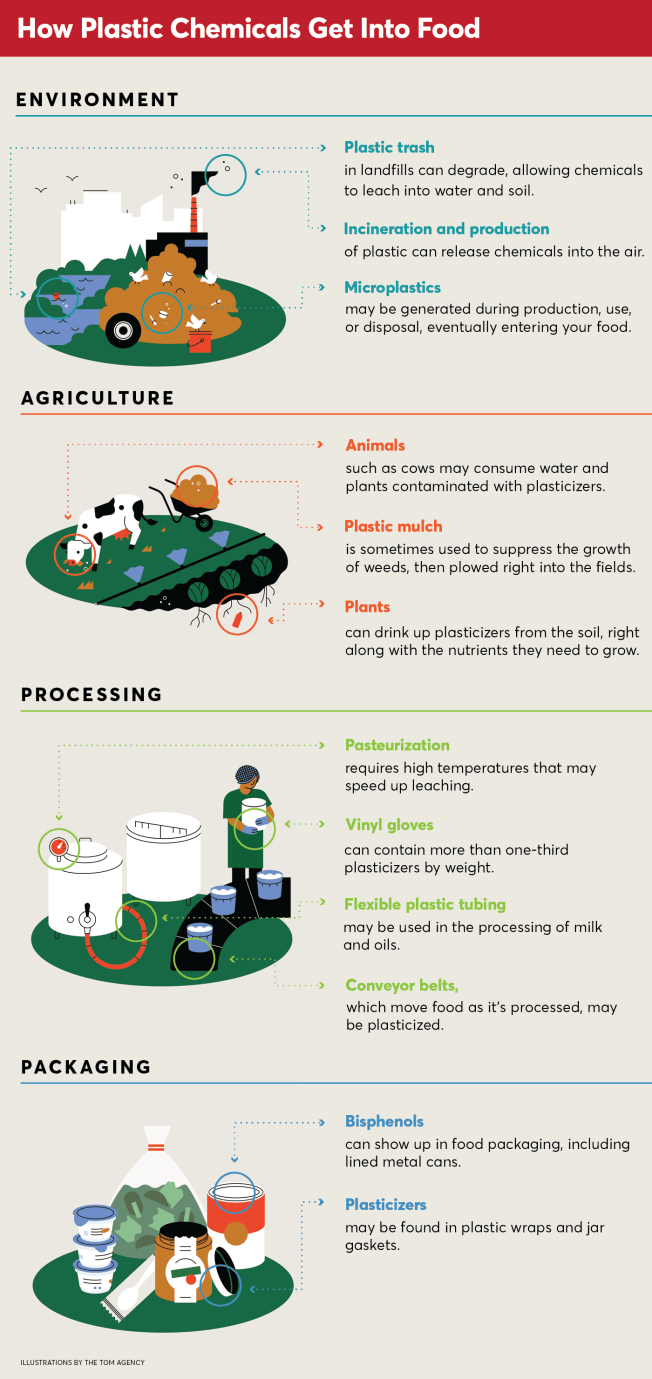
The 67 grocery store foods and 18 fast foods CR tested are listed in order of total phthalates per serving. While there is no level that scientists have confirmed as safe, lower levels are better. Our results show that although the chemicals are widespread in our food, levels can vary dramatically even among similar products, so in some cases you may be able to use our chart to choose products with lower levels.
Growing concerns about the health risks posed by these chemicals have led U.S. regulators to meaningfully curtail the use of these chemicals in a number of products—but not yet food.
For example, the federal government has banned eight phthalates in children』s toys. But, with the exception of a 2012 ban on BPA in baby bottles (extended in 2013 to infant formula cans), there are no substantive limits on plastic-related chemicals in food packaging or production. Although the Food and Drug Administration no longer allows certain phthalates in materials that come into contact with food, the agency updated its regulations only after those chemicals were no longer in use. And just last year, it rejected an appeal from several groups calling for a ban on multiple phthalates used in materials that come into contact with food.
An FDA spokesperson told CR that in 2022 it asked the food industry and others to provide the agency with additional data about the use of plasticizers in any material that comes into contact with food during production, and might use that information to update its safety assessments of the chemicals.
CR』s food safety scientists and others say such a reassessment by the FDA and other agencies is overdue and essential. 「Since bisphenols and phthalates are hazardous chemicals, they should not be allowed at all in food-contact materials,」 says Erika Schreder, the science director at Toxic-Free Future, an advocacy group.
Supermarket and fast-food chains, as well as food manufacturers, should also be required to take action, Rogers says, and should set specific goals for reducing and eliminating bisphenols and phthalates from all food packaging and processing equipment throughout their supply chains.
CR contacted certain companies in our tests that had products with the highest phthalate levels per serving, and asked them to comment on our results. Annie』s, Burger King, Fairlife, Little Caesars, Moe』s Southwest Grill, Wendy』s, and Yoplait did not respond to our requests for comment.
Del Monte, Gerber, and McDonald』s emphasized that they abide by existing regulations. Gerber added that it requires its suppliers to certify that its food packaging is free of BPA and phthalates. Chicken of the Sea said it requires its suppliers to certify that neither products nor packaging has intentionally added BPA or phthalates, but it acknowledged that fish live in water that is often polluted with phthalates.
More chemical companies need to step up, too, by creating safer, more sustainable materials. "We want things to be functional, but also nontoxic and biodegradable and renewable," says Hanno Erythropel, PhD, at the Center for Green Chemistry and Green Engineering at Yale University in New Haven, Conn.
That may be tough, he acknowledges, but it should be possible: An entire field called green chemistry is working to develop just these sorts of alternatives.
In the meantime, see our advice on what you can do now to limit your exposure to these chemicals.
Out of Our Food, 1998-2024
1998
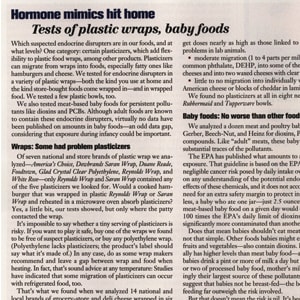
CR finds plasticizer chemicals called phthalates in some plastic wraps and cheeses, and asks the FDA to eliminate the chemicals from the food supply.
1999
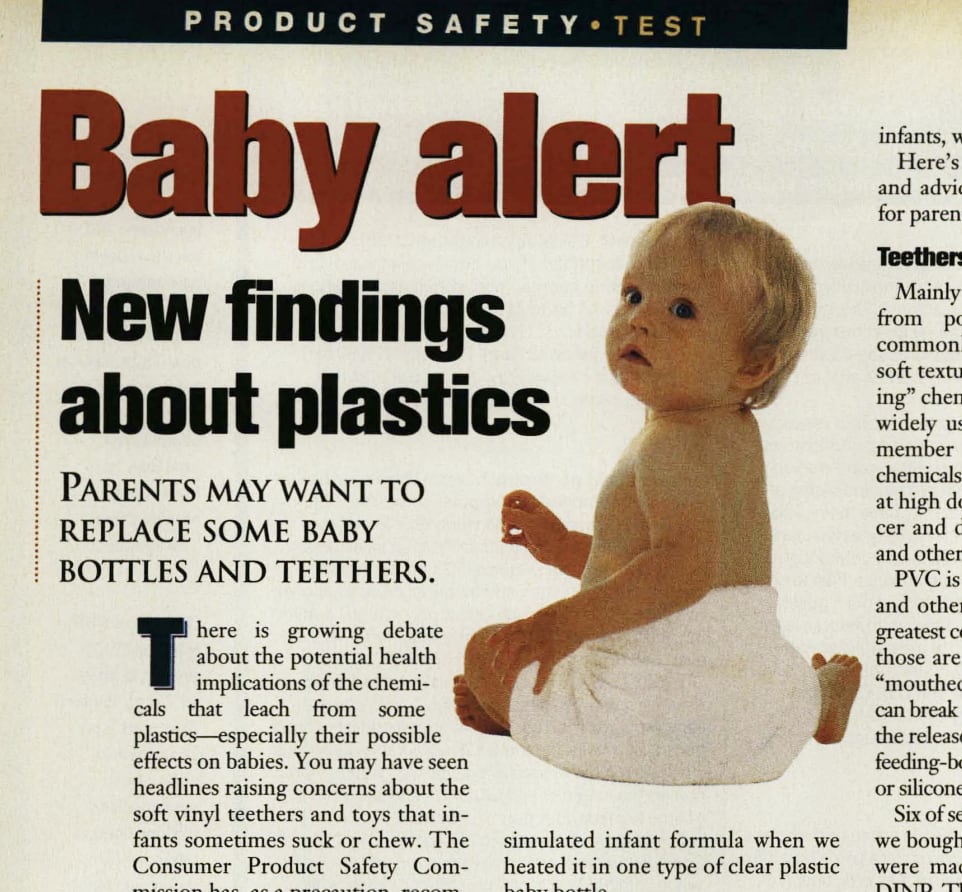
CR finds that BPA in plastic baby bottles can leach into infant formula and advises parents to throw away bottles that could contain the chemical.
2009

CR finds BPA in nearly all 19 tested foods and calls on government agencies to eliminate the chemical in materials that come in contact with food.
2012
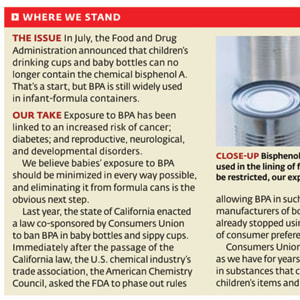
CR praises the FDA for banning BPA in baby bottles and sippy cups but calls on the agency to also ban the chemicals in infant formula containers and food cans. The FDA does so the following year.
2023

CR does not find BPA, lead, or certain phthalates in nine baby bottles but warns that related chemicals could still be present and cautions parents to consider using glass or silicone bottles.
2024
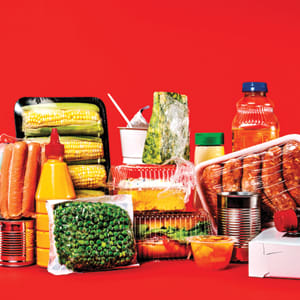
CR finds phthalates and related chemicals in nearly all 85 foods tested and calls on the FDA to get the chemicals out of food.
Editor』s Note: A version of this article published in the February 2024 issue of Consumer Reports Magazine incorrectly identified one of the products. It should have been Brisk Iced Tea lemon, not Lipton Brisk Lemonade. In addition, the package descriptions for several products in the chart of tested products have been changed to more accurately describe the materials used.
- [12/24]朱令同學
- [12/27]習近平神化泥胎毛澤東
- [12/30]貪婪的資本家貪婪的共產黨
- [01/03]李承鵬: 202X的宏大敘事與雞零狗碎
- [01/06]赫胥黎的勇敢新世界
- [01/07] The Plastic Chemicals Hiding in Your Food
- [01/15]聽完了「霍比特人」
- [01/19]東遊記
- [02/11]無月之下一老者
- [02/17]滑雪
- [02/22]換窗戶
- [02/25]100%發現率!人胎盤出現微塑料,肉眼可見;最新研究證實多器官受到影響
- [02/27]換窗紗
- 查看:[Brigade的.最新博文]
- 查看:[大家的.最新博文]
- 查看:[大家的.流水日記]
發表評論 評論 (3 個評論)

- 回復 Brigade
- https://www.consumerreports.org/health/food-contaminants/the-plastic-chemicals-hiding-in-your-food-a7358224781/

- 回復 Brigade
- 研究稱美國瓶裝水中發現大量納米塑料碎片,每升11萬
科學家利用激光對瓶裝水中數十萬個以前看不見的微小塑料顆粒進行了成像。Naixin Qian, 哥倫比亞大學
北京時間1月9日凌晨,國際學術期刊《美國國家科學院院刊》(PNAS)在線發表的一項最新研究稱,使用最新的檢測技術,研究人員在美國三種暢銷瓶裝水中發現大量微小塑料顆粒:每升瓶裝水中發現了11萬-37萬個塑料顆粒。其中,90%的塑料顆粒小於1微米,被稱為納米塑料。它們在此前的檢測中被忽視。
Recommended by
The Luxury Encore For Seniors Is Back With A Vengeance
The Luxury Encore For Seniors Is Back With A Vengeance
Black Friday Is Coming, Search Now! (Take A Look)
Commonsearches | Search Ads
You will never turn off your computer again. No Install. Play for free.
Strategy game CombatSiege
The 2024 Mitsubishi Outlander is Going For Great Deals (Take A Look)
The 2024 Mitsubishi Outlander is Going For Great Deals (Take A Look)
FrequentSearches
研究人員未透露這些瓶裝水的具體品牌。
該論文的標題是《利用SRS顯微鏡對納米塑料進行快速單顆粒化學成像》(Rapid single-particle chemical imaging of nanoplastics by SRS microscopy)。
納米塑料與微塑料不同。因為納米塑料更加微小,它們可以通過腸道或肺部細胞,進入血液,甚至抵達心臟和大腦。納米塑料甚至會穿過胎盤,進入胎兒體內。
人類頭髮的直徑約為70微米。微塑料被定義為尺寸從5毫米到1微米的塑料碎片。而納米塑料是尺寸小於1微米的顆粒,以十億分之一米為單位進行測量。
從極地冰層到土壤、飲用水和食物,研究人員稱,「有一個巨大的納米塑料世界有待研究。」
2018年的一項研究發現,瓶裝水中的塑料顆粒含量達平均每升含有325個。
但最新發表的這項新研究使用了一種被稱為受激拉曼散射顯微鏡(SRS)的檢測技術。兩束被調諧的激光使特定分子共振,來探測樣品。研究人員還計劃用該技術來檢測自來水。他們還將與環境健康專家合作,測量各種人體組織中的納米塑料,並檢查它們對發育和神經系統的影響。
全球每年的塑料產量接近4億噸。每年有超過3000萬噸的塑料被傾倒在水中或陸地上。許多由塑料製成的產品,包括合成紡織品,在使用過程中會脫落塑料顆粒。與天然有機物不同,大多數塑料不會分解成相對良性的物質。它們只是分裂成具有相同化學成分的越來越小的顆粒。除了單分子之外,理論上它們的大小沒有限制。
研究人員確定了前述瓶裝水中7種特定的納米塑料顆粒,比如聚苯乙烯、聚氯乙烯、PET(聚對苯二甲酸乙二醇酯)、聚醯胺(一種尼龍)等。
聚醯胺顆粒可能來自裝瓶前用於過濾凈化水的塑料過濾器,這種顆粒的數量超過了PET。
PET是很多塑料瓶的材料。當瓶子受到擠壓或受熱時,塑料顆粒可能脫落而進入水中。當人們反覆打開或關閉蓋子時,磨損產生的塑料顆粒也會進入水中。
一個令人不安的消息是,研究人員尋找到7種塑料顆粒類型僅占他們在樣本中發現的所有納米顆粒的10%左右。而其餘的塑料顆粒是什麼,人們還不知道。
- Smilingsnow:悲喜哀樂又一年
- riverview88:國務院形存實亡?
- 白色百合:微信支付
- Brigade:別人的愛情故事
- qxw66:物價猛如火?
- 釣魚城:一個金額達30億美元的驚天大案 - Jimmy 鐘的傳奇人生
- change?:白宮發布拜登習近平會見開場白內容視頻
- 釣魚城:月呀,何事長向別時園 - 永失愛我的母親
- qxw66:泛濫的國貨
- 老地雷:繼偉老師,一位名副其實的音樂領航員
- 謝盛友:慾望的另一面:女人到底要什麼
- 謝盛友:廣魯才英 文昌心伶
- julesoy:平凡和真實才讓人感動
- 謝盛友:德國的教會稅(Kirchensteuer)
- 謝盛友:德國三分之一人口擔任志願者
- qxw66:用法律反巨嬰,是中國一大發明
- 謝盛友:餐館失火后的傷痛
- 老地雷:他走了,留給我的是愛的傷疤
- 謝盛友:色戒: 中國女人與外國男人
- BANGZI:2023/05/14 周末搗鼓院子








